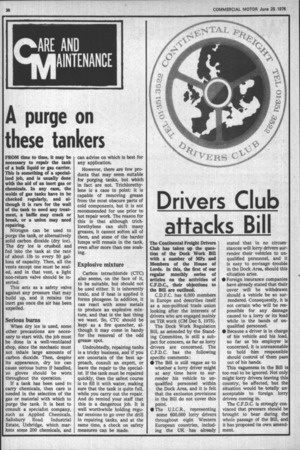A purge on
Page 40

If you've noticed an error in this article please click here to report it so we can fix it.
these tankers
FROM time to time, it may be necessary to repair the tank of a bulk liquid or gas carrier. This is something of a specialised job, and is usually done with the aid of an inert gas or chemicals. In any case, the welds of gas tanks have to be checked regularly, and although it is rare for the wail of the tank to need any treatment, a baffle may crack or break, or a union may need repairing.
Nitrogen can be used to purge the tank, or alternatively solid carbon dioxide (dry ice). The dry ice is crushed and fed into the tank at the rate of about 1lb to every 50 gallons of capacity. Then, all the vents except one must he sealed, and in that vent, a light non-return valve should be inserted.
This acts as •a safety valve against any pressure that may build up, and it retains the inert gas once the air has been expelled.
Serious burns
When dry ice is used, some other precautions are necessary to start with, the job must be done in a well-ventilated shop, since the mechanic must not inhale large amounts of carbon dioxide. Then, despite its appearance, dry ice can cause serious burns if handled, so gloves should be worn throughout the operation.
If a tank has been used to carry chemicals, then care is needed in the selection of the gas or material with which to purge the tank. It is best to consult a specialist company, such as Applied Chemicals, Salisbury Road Industrial Estate, Uxbridge, which markets some 200 chemicals, and can advise on which is best for any application.
However, there are few products that may seem suitable for purging tanks, but which in fact are not. Trichlorethylene is a case in point: it is capable of removing grease from the most obscure parts of cold components, but it is not recommended for use prior to hot repair work. The reason for this is that although trichlorethylene can shift many greases, it cannot soften all of them, and some of the harder lumps will remain in the tank, even after more than one soaking.
Explosive mixture
Carbon tetrachloride (CTC) also seems, on the face of it, to be suitable, but should not be used either. It is inherently toxic, and if heat is applied it forms phosgene. In addition, it can react with some metals to produce an explosive mixture, and that is the last thing we want. So, CTC should be kept as a fire quencher, although it may come in handy for the removal of the odd grease spot.
Undoubtedly, repairing tanks is a tricky business, and if you are uncertain of the best approach, consult an expert, or leave the repair to the specialist. If the tank must be repaired quickly, then the safest course is to fill it with water, making sure that the tank is quite full, while you carry out the repair. And do remind your staff that this is a dangerous job. It is well worthwhile holding regular sessions to go over the drill in repairing tanks, and at the same time, a check on safety measures can be made.




















































































